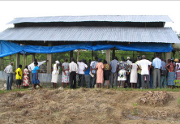
Haiti (MNN) — In Haiti, on the one-year anniversary of the
hunger riots, conditions seem to have worsened.
After food prices spiked and then
stabilized, things got much worse. Imported food prices skyrocketed, with rice
and beans doubling and tripling in price by August. Throw in a dock strike, which kept supplies rotting
in their containers, add this winter's yield, and the result is a resigned despair.
Bright Hope International is countering that despair in the
central city of Pignon. Residents there
face many challenges including lack of running water, limited access to
electricity, very little economic opportunity, and deplorable road conditions.
The main industries are small-scale farming and small retail shops located
outside people's ramshackle homes. With
four major storms that slammed into the region last fall, the devastation was
complete. They left
in their wake an estimated 1.0 billion dollars' worth of damages.
Haiti's Prime Minister Michelle
Pierre-Louis made an impassioned plea at this week's donor conference in
Washington. More money isn't the answer,
and he
acknowledged that Haiti needs major infrastructural improvement to
encourage investment, development and job creation.
That's where Bright Hope's project dovetails neatly with the
hope for a future. Donald Farrell
explains the practical usage of their micro-enterprise program. "With the $40 (USD), they got a machete,
a hoe, some seeds, and the periodic counsel of a professional
agronomist."
From there, the families work hard to repay the six-month
loans. In the first round, Farrell says
they saw an astonishing 97.5% rate of repayment. The percentage that couldn't pay were
struggling with natural disaster or other devastating trauma. Interestingly, their churches surrounded them
and helped them pay off their loans anyway, bringing the repayment rate of the
first phase loans to 100%.
The second phase development loans were between $60 and $80
(USD). "What we want to do is get from
dependency to self-sustainability," notes Farrell. By the end of the second loan cycle, the
ministry hopes to see stronger families who
are able to support themselves.
However, it's not all about the numbers. It's about transformation, too. "Pastors of the churches oversee the
administration of the program in their local hamlet. They identify the 10 most-needy families," multiplied by roughly 20 project zones.
In that way, Bright Hope reached 282 families in Central
Haiti. Projects like these have improved the quality of life in Pignon and strengthened
the Christian witness opportunities in their community.
Farrell says, "It's
the holistic Gospel at work. It's not just the preached Word, but the Holy
Spirit is equipping the extremely impoverished local church to help turn these
people from the abject poverty."
